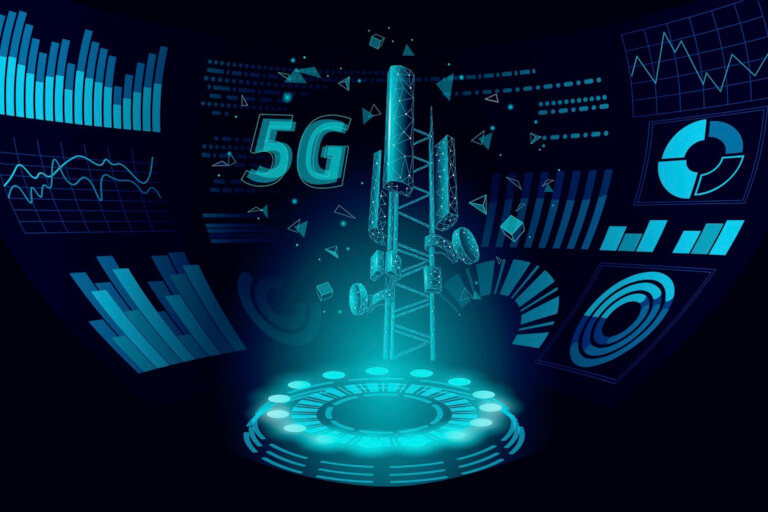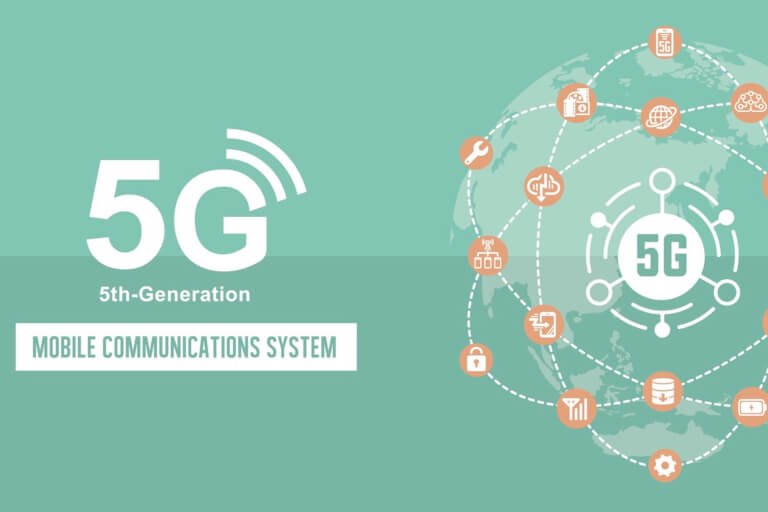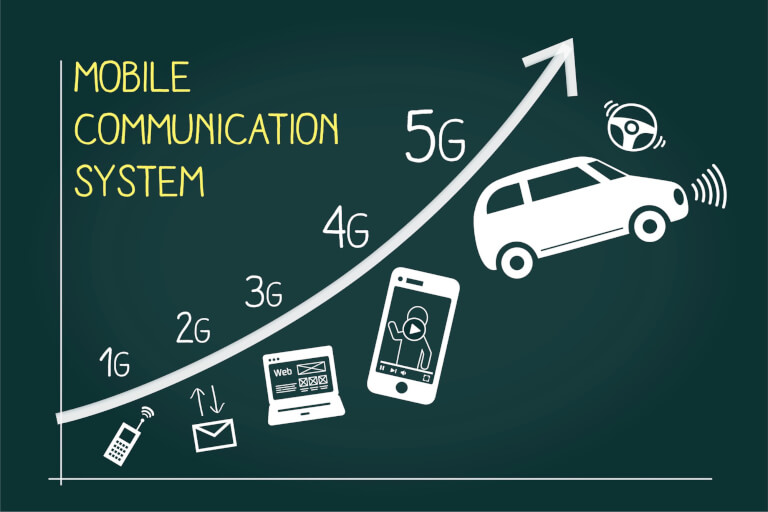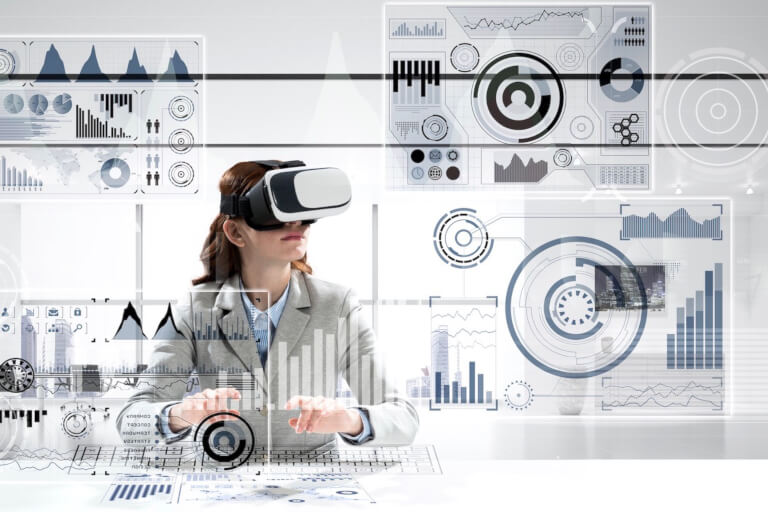5G stands for “ 5th generation mobile communication system ” and has three characteristics: “high speed and large capacity”, “high reliability and low latency communication” and “multiple simultaneous connections” . In Japan, commercial services will start in the spring of 2020, and it is said that as a next-generation communication infrastructure, it will bring major technological innovation to society.
In this article, we will explain in an easy-to-understand manner the mechanism and characteristics of 5G, the history of mobile communication systems, and what can be achieved in the 5G environment . Please also pay attention from the perspective of promoting DX to see how the use of 5G in existing industries will accelerate the introduction of IoT and how DX (digital transformation) will be realized.

What is 5G? Revise the meaning of words

First, let me explain what 5G means.
First of all, I will explain the meaning and origin of the word 5G.
Meaning of 5G
5G is an abbreviation for “5th Generation”, meaning the fifth generation of next-generation communication standards used for mobile phones. In Japanese, it is written as “5th generation mobile communication system” .
In September 2015, the 5G concept was announced for the first time in the report ” IMT Vision Recommendations ” prepared by the United Nations specialized agency “International Telecommunication Union” Radiocommunication Sector (ITU-R) . Here, at the same time as describing the main capabilities of communication speed and delay,
( 1 ) High speed and large capacity (eMBB: enhanced mobile broadband) (
2 ) Highly reliable and low latency communication (URLLC: Ultra-Reliable and Low Latency Communications) (
3 ) Multiple simultaneous connections (mMTC: massive Machine Type Communication)
Also mention the usage scenario. This scenario was agreed in 2017 as a technical performance requirement for 5G.
In addition, 3GPP, an organization promoting the international standardization of 5G, has also started a basic survey in response to the IMT vision recommendation. We summarized the specifications and requirements according to the scenario, and listed a total of 74 use cases such as VR, telemedicine, drone control, and automatic driving .
In 2019, 19 countries around the world, including the United States, South Korea, and the United Kingdom, started commercial 5G services. In Japan, starting in the spring of 2020, we are moving toward practical use not only for personal use but also for industry and business. In the future, it is a communication standard that has high expectations as a foundation for realizing DX.
★What is 5G?
- Abbreviation for “5th Generation”, meaning “fifth generation mobile communication system”
- It has three features: “high speed and large capacity”, “highly reliable and low latency communication”, and “multiple simultaneous connections”.
- It is attracting attention as a foundation for realizing DX
History of mobile communication systems up to 5G

Let’s look back on the history of mobile communication systems up to 5G
Mobile communication is communication using portable communication devices . In the past, it used to refer to communication performed while traveling by plane, ship, train, etc., but in 1979, Nippon Telegraph and Telephone Public Corporation, the predecessor of NTT, started a commercial service of “car phone”. This became the basis of mobile phones.
1G, the first-generation mobile communication system, was used there. From here, we will explain the history of mobile communication systems that have evolved about every 10 years since the 1980s, and the differences between 4G and 5G.
Introducing 1G to 3G in an easy-to-understand manner
First, I will explain the transition from 1G to 3G.
◇ Popularization of “1G” analog mobile phones
1G spread in the 1980s. In 1985, the portable phone “shoulder phone” appeared, and in 1987 the “mobile phone” appeared .
1G is an analog method that converts voice into signals carried by radio waves for communication . Therefore, the function is only voice call . Since there were also problems with communication quality and communication distance, the development of digital technology progressed.
◇ Popularization of “2G” email and Internet use
2G became popular in the 1990s. Communication methods have changed from analog to digital . Easier data communication has made it possible to use e-mail and connect to the Internet .
In 1999, NTT Docomo launched “ i-mode , ” which led this era. Mobile users can now download ringtones and standby screens, use mobile banking, map search services, etc., and expand business with mobile users . Following NTT Docomo, KDDI’s predecessor DDI Cellular Group launched “EZweb” and Softbank’s predecessor J-Phone launched “J-Sky”.
As the use of data communication became commonplace, the need for high-speed communication gradually increased.
◇ Spread of “3G” global standard high-speed communication
In the 2000s, 3G became popular, and the communication speed, which was 2.4 kbps to 28.8 kbps in 2G, improved significantly to 384 kbps to 14 Mbps. It became possible to enjoy more large-capacity content, and services on the platform such as “Chaku -Uta” increased at a stretch.
3G is the first international standard mobile communication system . Around this time, it became possible to use Japanese mobile phones overseas.
In 2008, Softbank released “iPhone 3G”. It became possible to comfortably connect to the Internet, and the need for high-speed, large-capacity communication has increased.
What is the difference between 5G and 4G?
In the 2010s, the number of smartphone users increased dramatically. 4G, which has a communication speed of 50 Mbps to 1 Gbps, which is still mainly used today, has supported this trend . With the dramatic improvement in communication speed, users can now enjoy large-capacity content such as mobile games and videos , as well as smooth Internet use .
The 2020s will be the era of 5G.
If 4G is “mobile network technology for smartphones” , 5G is said to be “mobile network technology that supports society “. This is because a wide range of use cases are expected in the IoT era where everything is connected to the Internet.
The three features that make this possible are “high-speed, large-capacity,” “high-reliability, low-delay communication,” and “multiple simultaneous connections .” Compared to 4G, the communication speed is expected to be 20 times faster, the delay is 1/10th, and the number of simultaneous connections is expected to be 10 times faster, and it is expected to be used in various services and businesses.
★ Summary of the history of mobile communication systems up to 5G
| 1G | Popularized in the 1980s. Analog method, mobile phone function is voice call only |
| 2G | Popularized in the 1990s. E-mail and the Internet can be used on mobile phones with the digital method. |
| 3G | Popularized in the 2000s. A global standard mobile communication system that can be used overseas. High-speed, high-capacity communications and more services on platforms |
| 4G | Popularized in the 2010s. With the spread of smartphones, high-speed and large-capacity communications have become possible, making it possible to watch videos and play mobile games. |
| 5G | Widespread in the 2020s. “High-speed, large-capacity,” “high-reliability, low-delay communication,” and “multiple simultaneous connections” are realized. For the communication infrastructure that forms the basis of the IoT era |
Three features of 5G and how they work
From here, we will explain the mechanism of 5G’s features of “high speed and large capacity”, “highly reliable and low latency communication”, and “multiple simultaneous connections” .
Features of 5G (1): High speed and large capacity
Technology to achieve high speed and large capacity
The key to “high-speed, large-capacity” is an antenna technology called ” Massive MIMO . ” This is a development of wireless communication technology “MIMO” using multiple antennas. It uses tens to hundreds of antenna elements to transmit data in high frequency bands .
Combined with this technology is ” beamforming , ” which narrows down radio waves and intensively emits them in a specific direction . This is to increase the strength of radio waves and achieve high-speed communication over long distances.
The maximum communication speed (downlink) target value set by the International Telecommunication Union is 20 Gbps . It is about 100 times faster than 4G in 2010, and about 20 times faster than NTT DoCoMo’s PREMIUM 4G, which started in the spring of 2019.
If high-speed, large-capacity communication is realized, we can expect live distribution of high-definition videos such as 4K and 8K, online home medical care, and highly accurate security systems using AI analysis .
Features of 5G (2): Highly reliable, low-latency communication
We will explain the technology that realizes highly reliable and low-latency communication.
The key to “highly reliable, low-latency communication” is ” edge computing . ” This is a technology that shortens the communication time by shortening the physical distance between the device and the server .
In normal communication, “cloud computing” is the mainstream, in which content is accessed in the flow of device → base station → Internet → cloud server, and downloaded in the reverse flow. On the other hand, edge computing can ensure real-time performance because the device → base station → server installed near the base station (edge) and the communication path is short .
Currently, the European Telecommunications Standards Institute (ETSI) is promoting the standardization of Multi -Access Edge Computing (MEC) . This is a technology that considers communication not only with smartphones, but also with multiple things including IoT devices and automobiles .
The International Telecommunications Union target transmission delay is 1ms . 4G was 10ms, so it’s a tenfold improvement. If a vehicle traveling at 60km/h is braked remotely, 4G has a free running distance of about 1.7m, while 5G has only a few centimeters. By improving transmission delay, it is possible to ensure the safety of passengers in an emergency.
In this way , low-latency communication technology is a key technology in the fields of remote control and telemedicine, which require high reliability .
5G feature ③: Multiple simultaneous connections
We will explain the technology that realizes multiple simultaneous connections.
We will explain the technology that realizes multiple simultaneous connections.
The key to “massive simultaneous connections” is the ” grant-free “ technology. This is to simplify communication between devices and base stations and increase the number of simultaneous device connections .
Normally, when communication is started between a device and a base station, the frequency to be used and the usage time are exchanged. After that, the base station issues a pre-authorization (grant) . Devices transmit data in any manner permitted by the base station.
Grant-free, on the other hand, allows data to be transmitted without the prior permission of the base station. This avoids communication congestion and allows many devices to access one base station at the same time. There is a risk of transmission failure, but it is designed with a mechanism for retransmission.
The International Telecommunication Union ‘s target for concurrent connections is 1 million devices/km2 . With 4G, it was 100,000 devices/㎢, so 10 times more devices can be connected. Not only is it comfortable to use smartphones at stadiums and live venues, but it is also an essential requirement in the IoT era where various things around us are connected to the Internet.
★Summary of differences between 4G and 5G
| communication speed | transmission delay | Simultaneous connections | |
|---|---|---|---|
| 4G | 1 Gbps | 10ms | 100,000 devices/㎢ |
| 5G | 20Gbps | 1ms | 1 million devices/㎢ |
Another technology supporting 5G is network slicing , which divides the network according to usage.
In the future, not only smartphones and PCs, but also IoT devices, automobiles, and all other things will be connected to networks. Among them, some require large capacity and some require low latency .
Therefore , network slicing is the virtual division (slicing) of the network by changing the unit of data transmission according to the application . We use the appropriate network for each content, such as a highly reliable, low-delay network for autonomous driving, and a high-speed, large-capacity network for 4K/8K streaming, to achieve smooth communication.
In this way, 5G is made up of various technologies. That is the foundation of DX that transforms people’s lives for the better.
★Summary of key points of 5G
| high speed large capacity | 20 times faster communication speed. “Massive MIMO” and “Beamforming” are used to enable high-definition video distribution and home medical care |
| Highly reliable, low latency communication | Transmission delay has evolved to 1/10. “Edge computing” is used to enable autonomous driving, telemedicine, etc. |
| Multiple simultaneous connections | The number of simultaneous connections has increased tenfold. “Grant-free” will be used to promote the adoption of IoT |
What is the 5G compatible smartphone area? Introducing the frequency allocation of each company
Introducing the allocation of 5G frequencies by major telecom companies
In 2019, the Ministry of Internal Affairs and Communications accepted an application to open a specific base station for the introduction of 5G. Four companies , NTT Docomo, KDDI, Softbank, and Rakuten Mobile, applied . Based on the opening plans submitted by each company, a review was conducted to allocate 6 slots for the 3.7GHz/4.5GHz band (100MHz width each) and 4 slots for the 28GHz band (400MHz width each).
The examination item now incorporates the ” base development rate “ instead of the conventional population coverage rate . This is the ratio of base stations placed in approximately 4,500 blocks, excluding areas such as uninhabited areas, with all of Japan divided into 10km square meshes . This standard was adopted because 5G is expected to solve social issues on a national level, not only in urban areas but also in rural areas.
From here, we will introduce the services and frequencies of each company, as well as an overview of their plans to establish new networks.
NTT DoCoMo
NTT DoCoMo has acquired two 3.7GHz/4.5GHz bands (3600-3700MHz, 4500-4600MHz) and one 28GHz band (27.4-27.8GHz). The capital investment is about 795 billion yen, aiming for a 97.0% infrastructure deployment rate in FY2023, and plans to deploy 20,000 stations nationwide by March 2022 .
Since the start of the service, NTT Docomo has released 5G compatible smartphones and Wi-fi routers such as the 5G compatible iPhone series, “Galaxy”, “Xperia”, and “AQUOS” series. The 5G service coverage area is gradually expanding.
KDDI
KDDI also acquired two 3.7GHz/4.5GHz bands (3700-3800MHz, 4000-4100MHz) and one 28GHz band (27.8-28.2GHz). The capital investment will be approximately 466.7 billion yen, aiming for a base deployment rate of 93.2% by the end of fiscal 2024, and plans to deploy 50,000 stations nationwide by March 2022 .
Since the start of the service, KDDI has released 5G compatible smartphones such as the 5G compatible iPhone series, “Galaxy”, “Xperia”, “AQUOS”, “OPPO”, “TORQUE”, and “Google” series. The 5G service coverage area is gradually expanding.
Softbank
Softbank was given a point difference with NTT Docomo and KDDI in the examination, and the 3.7 GHz / 4.5 GHz band was allocated one frame (3900-4000 MHz). 28GHz band gets 1 frame (29.1-29.5GHz). The amount of capital investment will be approximately 206.1 billion yen, and the Ministry of Internal Affairs and Communications has announced that it will aim for a 64.0% infrastructure deployment rate by the end of fiscal 2024 . We plan to expand the base to 50,000 stations by the end of FY2021 and 200,000 stations by the end of FY2025 .
As an individual condition for SoftBank, the Ministry of Internal Affairs and Communications requested thorough measures to prevent recurrence based on the large-scale communication failure that occurred in December 2018.
Since the start of the service, SOFTBANK has released 5G compatible smartphones such as the 5G compatible iPhone series, as well as the “Google”, “LEITZ”, “AQUOS”, “Xperia”, “razr”, and “Redmi Note” series. The 5G service coverage area is gradually expanding.
Rakuten Mobile
Rakuten Mobile has acquired one 3.7GHz /4.5GHz band (3800-3900MHz) and one 28GHz band (27.0-27.4GHz). The amount of capital investment will be approximately 194.6 billion yen, and we are aiming for a infrastructure development rate of 56.1% by the end of fiscal 2024.
Rakuten Mobile has just entered the mobile phone business. The Ministry of Internal Affairs and Communications requested the steady establishment of base stations as a separate condition for future development.
Since the launch of the service, Rakuten Mobile has released 5G compatible smartphones such as the 5G compatible iPhone series, the “Rakuten” series and the “OPPO” series, which are its own original terminals. The 5G service coverage area is gradually expanding.
What can be realized in the 5G environment?

What services will 5G change?
The spread of 5G will make possible things that were previously impossible, and will bring about major changes in our lives, businesses, and society. Here, we introduce cases where 5G can be utilized.
4K/8K live streaming
5G’s “high-speed, large-capacity” and “high-reliability, low-latency communication” will enable live distribution of high-definition video such as 4K and 8K. You can deliver powerful images to users watching at home and spectators in large venues such as stadiums.
Highly immersive VR/AR experience
“XR”, which includes VR and AR, is a field where significant quality improvement is expected. With a headset on, you can enjoy live music and watch sports from any angle as if you were in the front row. The overwhelming immersive feeling will create a new viewing experience.
Diversification of sports viewing
Telecommunications companies have already completed demonstration experiments for watching sports using 5G. KDDI provided a service that allowed spectators to watch the game from multiple perspectives in real time at the official professional baseball game, and NTT Docomo at the Rugby World Cup 2019 in Japan. The Ministry of Internal Affairs and Communications estimates that the economic effect of updating sports viewing will reach approximately 237.3 billion yen.
Utilization of remote technology
In fields that require remote technology, 5G’s “high-speed, large-capacity” and “high-reliability, low-delay communication” will be important. In the medical field, “remote surgery support,” in which doctors remotely provide advice during surgery, will advance. Also, in the future, the day may come when a doctor in a distant place can perform “remote surgery” instead of a doctor on site. It will be possible to remotely control excavators and other equipment at construction sites and disaster recovery sites to achieve reliable and safe construction.
Promotion of autonomous driving
One of the most anticipated applications of 5G is self-driving cars. A “connected car” connected to a network constantly communicates information such as vehicle status, pedestrian locations, traffic conditions, and a digital map “dynamic map” with a server. It is believed that traffic accidents and traffic congestion can be reduced through emergency steering control and platooning.
Acceleration of IoT
5G, which enables “multiple simultaneous connections,” will accelerate the adoption of IoT. In the medical field, multiple medical devices and hospital equipment are connected to the Internet, and in agriculture, weather, soil, growth sensors, etc. are connected to the Internet, and a huge amount of data is collected. AI analyzes it to improve accuracy. In commercial facilities, customer flow analysis can be used for marketing, and real-time inventory management and automatic ordering are also possible.
[Free e-book] Click here to download the basic knowledge of IoT utilization that is useful for promoting DX
Promotion of work style reform
The use of 5G is indispensable for “creating an environment that facilitates flexible work styles,” which is one of the work style reforms. With “high-speed, large-capacity” communication, you can hold video conferences and share large files smoothly as if you were in the same space, so remote work will become commonplace. This will make it easier to balance work with childbirth, childcare, and nursing care.
★ What can be achieved in the 5G environment Summary
| subject | what you can do |
|---|---|
| 4K/8K live streaming | You can enjoy high-definition images with little time lag. It will be possible to deliver realistic images to stadium event participants and users watching at home. |
| VR/AR experience | Using a headset, you can enjoy high-definition and smooth images. Used for live performances, stadium events, online games, etc., creating highly immersive content |
| watching sports | You can watch sports from multiple angles using your device or VR headset. You can also check data such as battle records and highlight scenes with one touch. |
| remote technology | In the medical field, remote surgery support using IoT will improve. In dangerous cases such as construction sites and disaster recovery sites, remote control of equipment protects the safety of workers. |
| self-driving | A “connected car” that is connected to the Internet will help reduce traffic accidents and traffic congestion by understanding the driver and the situation outside. |
| IoT | It is expected to be effective in various fields, such as improving the accuracy and safety of surgery in medicine, and improving yields and work efficiency in agriculture. In commercial facilities, highly accurate marketing strategy planning is also possible through flow analysis. |
| work style reform | Remote work has become popular because large amounts of data can be sent without delay. Easier to balance work such as childcare and nursing care |
Summary: Utilization of 5G required for all companies

Utilization of 5G will revolutionize business
Q.
What can be realized in the 5G environment?
A.
5G stands for “5th generation mobile communication system” and has three characteristics: “high speed and large capacity”, “high reliability and low latency communication”, and “multiple simultaneous connections”. If you would like to know more about 5G use cases , please see 5G Use Cases to Accelerate DX Promotion .
Q.
What can be realized in the 5G environment?
A.
4K/8K live streaming, VR/AR experiences, and the acceleration of IoT are expected to bring about major changes in our lives, businesses, and society.
The benefits of the introduction of 5G are not limited to improved communication speeds. By combining the excellent features of “high-speed, large-capacity,” “high-reliability, low-delay communication,” and “multiple simultaneous connections,” it has become possible to achieve things that were previously impossible, and society has changed dramatically. I will continue.
5G will be a powerful foundation not only for personal use, but also for companies to develop new products and services. It is no exaggeration to say that correctly understanding the characteristics of 5G and what can be achieved using 5G is the key to promoting DX .

